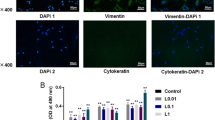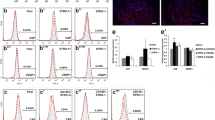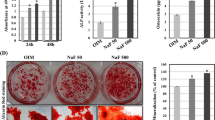Abstract
Elevated extracellular calcium has been shown to promote the differentiation of osteoblasts. However, the way that calcium affects the osteogenic differentiation of human periodontal ligament stem/progenitor cells (PDLSCs) remains unclear. Our aim has been to investigate the proliferation and osteogenic differentiation of a calcium-exposed human PDLSC line (cell line 1–17) that we have recently established and to elucidate the roles of the calcium-sensing receptor (CaSR) and L-type voltage-dependent calcium channel (L-VDCC) in this process. Proliferation activity was investigated by WST-1 assay, and gene and protein expression was examined by quantitative reverse transcriptase plus the polymerase chain reaction and immunostaining, respectively. Calcification assay was performed by von Kossa and Alizarin red staining. Treatment with 5 mM CaCl2 significantly induced proliferation, bone-related gene expression, and calcification in cell line 1–17. During culture with 5 mM CaCl2, this cell line up-regulated the gene expression of CaSR, which was reduced after 7 days. Simultaneous treatment with NPS2143, a CaSR inhibitor, and calcium significantly further increased bone-related gene expression and calcification as compared with CaCl2 exposure alone. The L-VDCC inhibitor, nifedipine, significantly suppressed osteogenic differentiation of cell line 1–17 treated with 5 mM CaCl2 and promoted the expression of CaSR, as compared with calcium treatment alone. Thus, elevated extracellular calcium promotes the proliferation and osteogenic differentiation of a PDLSC line. Antagonizing CaSR further enhances the effect of calcium on osteogenic differentiation, with CaSR expression being regulated by L-VDCC under extracellular calcium. Extracellular calcium might therefore modulate the osteogenic differentiation of PDLSCs through reciprocal adjustments of CaSR and L-VDCC.







Similar content being viewed by others
References
Barradas AM, Fernandes HA, Groen N, Chai YC, Schrooten J, Peppel J van de, Leeuwen JP van, Blitterswijk CA van, Boer J de (2012) A calcium-induced signaling cascade leading to osteogenic differentiation of human bone marrow-derived mesenchymal stromal cells. Biomaterials 33:3205–3215
Bohlooli S, Mahmoudian M, Skellern GG, Grant MH, Tettey JN (2004) Metabolism of the dihydropyridine calcium channel blockers mebudipine and dibudipine by isolated rat hepatocytes. J Pharm Pharmacol 56:1469–1475
Brown EM, Gamba G, Riccardi D, Lombardi M, Butters R, Klfor O, Sun A, Hediger MA, Lytton J, Hebert SC (1993) Cloning and characterization of an extracellular Ca(2+)-sensing receptor from bovine parathyroid. Nature 366:575–580
Cervantes D, Crosby C, Xiang Y (2010) Arrestin orchestrates crosstalk between G protein-coupled receptors to modulate the spatiotemporal activation of ERK MAPK. Circ Res 106:79–88
Dvorak MM, Siddiqua A, Ward DT (2004) Physiological changes in extracellular calcium concentration directly control osteoblast function in the absence of calciotropic hormones. Proc Natl Acad Sci U S A 101:5140–5145
Freeman E (1994) Periodontium. In: Ten Cate AR (ed) Oral histology: development, structure, and function. Mosby, St. Louis, pp 276–312
Fujii S, Maeda H, Wada N, Kano Y, Akamine A (2006) Establishing and characterizing human periodontal ligament fibroblasts immortalized by SV40T-antigen and hTERT gene transfer. Cell Tissue Res 324:117–125
Gould TR, Melcher AH, Brunette DM (1980) Migration and division of progenitor cell populations in periodontal ligament after wounding. J Periodontol 15:20–42
Gowen M, Stroup GB, Dodds RA, James IE, Votta BJ, Smith BR, Bhatnagar PK, Lago AM, Callahan JF, DelMar EG, Miller MA, Nemeth EF, Fox J (2000) Antagonizing the parathyroid calcium receptor stimulates parathyroid hormone secretion and bone formation in osteopenic rats. J Clin Invest 105:1595–1604
Ivanovski S, Li H, Haase HR, Bartold PM (2001) Expression of bone associated macromolecules by gingival and periodontal ligament fibroblasts. J Periodontal Res 36:131–141
Kobayashi M, Takiguchi T, Suzuki R, Yamaguchi A, Deguchi K, Shionome M, Miyazawa Y, Nishihara T, Nagumo M, Hasegawa K (1999) Recombinant human bone morphogenetic protein-2 stimulates osteoblastic differentiation in cells isolated from human periodontal ligament. J Dent Res 78:1624–1633
Lee KS, Kim HJ, Li QL, Chi XZ, Ueta C, Komori T, Wozney JM, Kim EG, Choi JY, Ryoo HM, Bae SC (2000) Runx2 is a common target of transforming growth factor beta1 and bone morphogenetic protein 2, and cooperation between Runx2 and Smad5 induces osteoblast-specific gene expression in the pluripotent mesenchymal precursor cell line C2C12. Mol Cell Biol 20:8783–8792
Lorch G, Viatchenko-Karpinski S, Ho HT, Dirksen WP, Toribio RE, Foley J, Györke S, Rosol TJ (2011) The calcium-sensing receptor is necessary for the rapid development of hypercalcemia in human lung squamous cell carcinoma. Neoplasia 13:428–438
Maeda H, Wada N, Nakamuta H, Akamine A (2004) Human periapical granulation tissue contains osteogenic cells. Cell Tissue Res 315:203–208
Maeda H, Nakano T, Tomokiyo A, Fujii S, Wada N, Monnouchi S, Hori K, Akamine A (2010) Mineral trioxide aggregate induces bone morphogenetic protein-2 expression and calcification in human periodontal ligament cells. J Endod 36:647–652
Maeda H, Tomokiyo A, Koori K, Monnouchi S, Fujii S, Wada N, Kono K, Yamamoto N, Saito T, Akamine A (2011) An in vitro evaluation of two resin-based sealers on proliferation and differentiation of human periodontal ligament cells. Int Endod J 44:425–431
Maeda H, Fujii S, Tomokiyo A, Wada N, Akamine A (2013) Periodontal tissue engineering: defining the triad. Int J Oral Maxillofac Implants 28:e461–e471
Melcher AH (1976) On the repair potential of periodontal tissues. J Periodontol 47:256–260
Meyer JR (1986) The regenerative potential of the periodontal ligament. J Prosthet Dent 55:260–265
Monnouchi S, Maeda H, Fujii S, Tomokiyo A, Kono K, Akamine A (2011) The roles of angiotensin II in stretched periodontal ligament cells. J Dent Res 90:181–185
Nohutcu RM, McCauley LK, Koh AJ, Somerman MJ (1997) Expression of extracellular matrix proteins in human periodontal ligament cells during mineralization in vitro. J Periodontol 68:320–327
Peterlik M, Kállay E, Cross HS (2013) Calcium nutrition and extracellular calcium sensing: relevance for the pathogenesis of osteoporosis, cancer and cardiovascular diseases. Nutrients 22:302–327
Potten CS, Schofield R, Lajtha LG (1979) A comparison of cell replacement in bone marrow, testis and three regions of surface epithelium. Biochim Biophys Acta 560:281–299
Seo BM, Miura M, Gronthos S, Bartold PM, Batouli S, Brahim J, Young M, Robey PG, Wang CY, Shi S (2004) Investigation of multipotent postnatal stem cells from human periodontal ligament. Lancet 364:149–155
Sharan K, Siddiqui JA, Swarnkar G, Chattopadhyay N (2008) Role of calcium-sensing receptor in bone biology. Indian J Med Res 127:274–286
Sun W, Sun W, Liu J, Zhou X, Xiao Y, Karaplis A, Pollak MR, Brown E, Goltzman D, Miao D (2010) Alterations in phosphorus, calcium and PTHrP contribute to defects in dental and dental alveolar bone formation in calcium-sensing receptor-deficient mice. Development 137:985–992
Takaoka S, Yamaguchi T, Yano S, Yamauchi M, Sugimoto T (2010) The calcium-sensing receptor (CaR) is involved in strontium ranelate-induced osteoblast differentiation and mineralization. Horm Metab Res 42:627–631
Tomokiyo A, Maeda H, Fujii S, Wada N, Shima K, Akamine A (2008) Development of a multipotent clonal human periodontal ligament cell line. Differentiation 76:337–347
Tomokiyo A, Maeda H, Fujii S, Monnouchi S, Wada N, Kono K, Yamamoto N, Koori K, Teramatsu Y, Akamine A (2012) A multipotent clonal human periodontal ligament cell line with neural crest cell phenotypes promotes neurocytic differentiation, migration, and survival. J Cell Physiol 227:2040–2050
Triggle DJ (1990) Calcium, calcium channels, and calcium channel antagonists. Can J Physiol Pharmacol 68:1474–1481
Wen L, Wang Y, Wang H, Kong L, Zhang L, Chen X, Ding Y (2012) L-type calcium channels play a crucial role in the proliferation and osteogenic differentiation of bone marrow mesenchymal stem cells. Biochem Biophys Res Commun 424:439–445
Xu Z, Yan L, Ge Y, Zhang Q, Yang N, Zhang M, Zhao Y, Sun P, Gao J, Tao Z, Yang Z (2012) Effect of the calcium sensing receptor on rat bone marrow-derived mesenchymal stem cell proliferation through the ERK1/2 pathway. Mol Biol Rep 39:7271–7279
Yamaguchi T, Chattopadhyay N, Kifor O, Butters RR Jr, Sugimoto T, Brown EM (1998) Mouse osteoblastic cell line (MC3T3-E1) expresses extracellular calcium (Ca2+o)-sensing receptor and its agonists stimulate chemotaxis and proliferation of MC3T3-E1 cells. J Bone Miner Res 13:1530–1538
Zayzafoon M (2006) Calcium/calmodulin signaling controls osteoblast growth and differentiation. J Cell Biochem 97:56–70
Acknowledgments
We thank Drs. Monnouchi, Teramatsu, Yuda, and Mizumachi for their great support in the preparation of this work.
Author information
Authors and Affiliations
Corresponding author
Additional information
This work was financially supported by Grants-in-Aid for Scientific Research (Project nos. 23659890, 23689077, 24390426, 24659848, 24792028, 25293388, and 25670811) from the Japan Society for the Promotion of Science.
Rights and permissions
About this article
Cite this article
Koori, K., Maeda, H., Fujii, S. et al. The roles of calcium-sensing receptor and calcium channel in osteogenic differentiation of undifferentiated periodontal ligament cells. Cell Tissue Res 357, 707–718 (2014). https://doi.org/10.1007/s00441-014-1918-5
Received:
Accepted:
Published:
Issue Date:
DOI: https://doi.org/10.1007/s00441-014-1918-5




